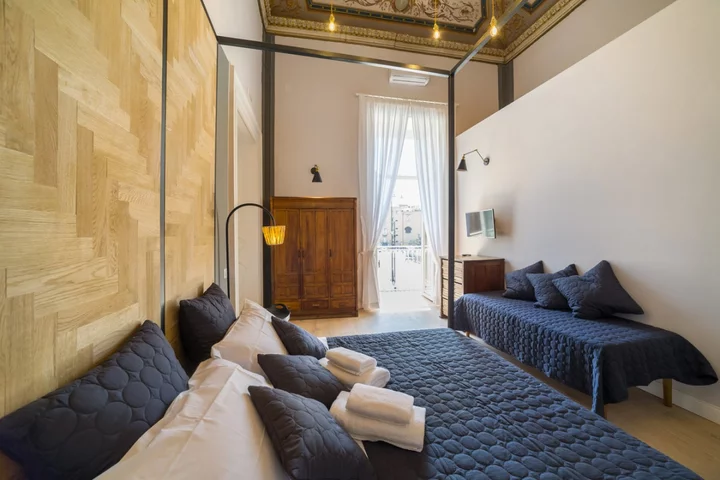
The Dante House, Naples, review: Luxury hotel chic meets B&B practicality
In a nutshell: A rare find where the boutique chic of a luxury hotel meets the functionality and independence of a B&B. The neighbourhood There really is something about Naples – it’s rough and ready, it’s energetic, it’s alive. This authentic charm is exactly why the city will have you planning your next visit before you’ve even finished your first. At first glance it can seem chaotic. Mopeds speed in and out of traffic (we’re told by several locals that they’re actually very good drivers and never crash), barely a wall in the city isn’t covered in graffiti and street art, and the nights (even mid-week) buzz with the chatter of locals and tourists alike. But it’s the pull of this organised chaos that (as a former New Yorker) led me to enthusiastically proclaim the city “Europe’s Brooklyn”. Then again, it’s also so much more than that. What Naples offers is a blend of old and new that at once clashes and coexists beautifully – here, you can experience ancient history and the coolest bars, all in one place. By day, explore the old town, where every turn surprises you with another ancient church, cobbled street or historic home. Take a tour of the underground of the city and walk through tunnels trod by the Romans. Walk to the high point of Castel Sant’Elmo to look down on the iconic Spaccanapoli – the straight and narrow main street that literally splits the city in two – or pay a visit to the square in the Spanish quarter, which has been transformed into a shrine to one of football’s biggest legends: Maradona (to say he’s idolised here would be a major understatement). By night, the city comes even more alive as groups of friends gather in the historic squares and at homely restaurants and effortlessly trendy bars, where people laugh, drink, smoke and eat gelato into the night. As the home of pizza, it’s also a food-lover’s delight. Wander the streets sampling the classic margherita and marinara pizzas, try the famous deep-fried pasta (trust me, it’s worth it) and get a deli sandwich unlike any other, with the freshest meats and cheese around. Naples has the added benefit of also being considerably more budget-friendly than some of its neighbouring Italian hotspots (here, a classic margherita or marinara pizza from the city’s most popular pizza places will set you back just two or three euros). So, as well as enjoying all that Naples has to offer, this makes it a great base to travel further afield during a stay in Italy – visit the historic ruins of Pompeii or Herculaneum, the MountVesuvius volcano, the lemon groves of Sorrento, the designer stores of affluent island Capri or the picturesque Amalfi Coast towns of Positano and Amalfi. The vibe The Dante House is the latest addition to the House in Naples’s fleet of four boutique B&Bs as well as apartments dotted across Naples’s historic centre. The concept is all about catering to travellers who want the quality of a hotel but don’t want the impersonality that can often come with it. With each location carefully handpicked and each perfectly unique and with its own character, it certainly delivers just that. Located on Piazza Dante at Port’Alba, The Dante House is right by one of the historic city gates encasing the old town and also conveniently just steps away from the Dante metro stop. At first glance, when you arrive outside the The Dante House in the heart of the historic old town, you could be forgiven for thinking you’re in the wrong place. Nestled between a late-night pizza spot and a casual, local bar, heavy, metal doors loom from a nondescript grey concrete building. There’s no sign confirming you’ve reached your destination. But step through the metal doors, and you’ll find yourself inside a classic, traditional Italian palazzo building. Climb up the huge slab stone stairs to the towering wooden double doors and you’ll be at The Dante House. This is where your real Neapolitan adventure begins. After all, what better way to experience the historic, vibrant city of Naples than to live like a local in a traditional Neapolitan house? Though the building may date from the 18th century, The Dante House manages to perfectly mix old and new, with its clean and modern interior renovation. It’s practical while being quirky; industrial but with boutique style; chic and modern but true to its original architecture – an embodiment of Naples itself. When we arrived, Connie was waiting to welcome us and show us around – not to mention enthusiastically give us her own personal and fantastically comprehensive guide to the best things to see and do in the city. The overall vibe is relaxed, and staff are super helpful and friendly – with excellent communication both in the lead-up to and during our stay – but are also hands off, if you’re more of an independent traveller. Basically, they’re there if you want them but they’ll leave you alone if you don’t. The reception is only staffed up to 8pm but one of the friendly staff members will come to greet late arrivals, there’s a 24/7 number for any queries and there’s also the option to arrange transfers from the airport or train station. If you’re someone who likes an all-inclusive hotel or a place that will plan your every holiday whim for you, this isn’t the place for you. Instead, this is perfect for independent travellers who want a comfortable, relaxed place to stay that’s more luxurious than your regular B&B but still acts as the perfect base from which to explore the city. Being situated in the heart of one of Naples’s most prominent historic squares, The Dante House couldn’t be in a better location to do exactly that. You’re close to some of the best bars, restaurants and pizza joints, and within walking distance to all the historic sites. Bed and bath None of the six rooms in The Dante House’s boutique B&B are the same. Some have quirky mezzanine levels, some have wrought iron balconies, some have spectacular views across the square. All have character. Seriously high wooden or frescoed ceilings give the huge rooms a decorative canopy, while light floods through the french doors. Handmade and restored vintage furniture has been reworked to embody The Dante House’s style: combining old and new. Nordic-inspired furnishings and touches of plush velvet perfectly clash and complement the industrial-style lighting and functional wood panels. Rooms and suites sleep between three and six people – some have kitchenettes, so they’re perfect for groups of all sizes. We stayed in the Dante 2 family studio apartment located in the same building as The Dante House, giving us access to the staff and the communal spaces – but also the privacy and peace and quiet of our own space. For a couple, family or group of friends on a city break, this option is the perfect middle ground. The apartment itself was spacious and functional – with a bedroom area, dining table and chairs, and a large kitchenette to cook in, if you so wish. There’s also a separate bathroom (complete with complimentary toiletries) and a small single bedroom, so up to four can sleep comfortably. It also has a washing machine, 32in smart TV, sheets and towels included. Decor-wise, it’s clean and simple with a few quirky pieces (such as a unique towering green wardrobe), which truly sets it apart from your usual B&Bs. All in all, it leans into the charm and edginess of the city waiting outside. The one downside (if we were to be picky) is the lack of windows and natural light. But, for us, this all added to the charm and quirkiness of the apartment, with its interior-facing window to the courtyard – which also meant less noise from the lively city outside. All in all, The Dante House is a far cry from a typical B&B. It’s somewhere between your home away from home and a luxury hotel. Food and drink Breakfast is a big draw at The Dante House. It’s buffet-style and has clearly been carefully curated with the best-quality ingredients in the way of fresh, organic, homemade and zero km foods. From delicious homemade yoghurt and dried fruit (prepared fresh every day), freshly baked croissants and sfogliatelle pastries (a classic Italian specialty handmade in House in Naples’s own bakery), to ready-made rolls with fresh cold cuts and cheeses. The breakfast area itself also perfectly matches The Dante House’s vibe, with its boutique-style plush velvet seats coupled with a laidback, homely feel, as though you’re sitting in a friend’s home. Sip freshly squeezed orange juice and freshly roasted coffee from a window seat overlooking the historic square below. It’s the perfect start to a day exploring the city. Later in the afternoon, there’s also coffee and tea available – just in time for a much-needed pit stop after wandering around the city. Public areas The blend of old meets new, industrial meets luxury and functional meets quirky runs through all the spaces at The Dante House. The reception area is all tiled flooring, vibrant teal wall, wooden desk and – most intriguing – a wall covered in old telephones. As a B&B concept, it, of course, doesn’t have the amenities of a hotel (though the last thing you have time for in Naples is a trip to the gym). What it does have, however, is Posca – its cafe come bistro come bar just steps from The Dante House and right in the middle of the beating heart of the city. By day, it’s a hip spot for freshly roasted coffee, homemade cakes and brunch. By night, it’s a quirky cocktail bar – which also brews its own beers – where friends can meet for an aperitivo. We visited on a Wednesday night and sampled the cocktails, which come in the form of twists on popular classics, drinking alfresco on the cobbled street out front among the buzz of the city. Inside the bar, the House in Naples’s creators surprised us yet again with the decor – think vibrant pink floral wallpaper, pink velvet and neon signs. To make it even more appealing, guests at The Dante House can get a discount off the bar tab. Nuts and bolts Room count: Six rooms at The Dante House, four apartments. Freebies: Breakfast, coffee and tea bar. Wifi: Free. Extra charges: Tourist tax of €2.50 per person per day. Parking €30 per day. Disability access: Due to its many stairs and steps, it is not wheelchair accessible. Pet policy: Pets allowed, upon request. Bottom line Best thing: The location right in the heart of the action, and the unique style. Worst thing: It can be a little noisy in the mornings, as the area is home to other businesses and local residents (though it’s not a bad thing to make sure you don’t miss a day of exploring). Perfect for: Families, couples and friends who want the luxury of a hotel coupled with the freedom and homeliness of a B&B. Not right for: People who like the round-the-clock service and all-inclusivity of a typical hotel. Instagram from: One of The Dante House’s eight balconies overlooking the historic square below. Read more of our Italy hotel reviews: Best hotels in Rome Where to stay in Venice Best hotels in Florence Read more about Italy travel: The ultimate guide to Italy What to do in Bologna Why Puglia makes for a great escape Read More Le Sirenuse, Positano, review: Exclusive luxury meets the intimacy of a family vacation home Best hotels in Europe 2023, from boho chic to Art Deco design Cala di Volpe hotel review: Live like royalty on Sardinia’s Costa Smeralda The 10 best countries for solo travel – and top tips for travelling alone 9 of the best Italy holiday destinations: When to travel and where to stay 8 best cities and towns in Portugal to visit on your next holiday
2023-07-25 01:21
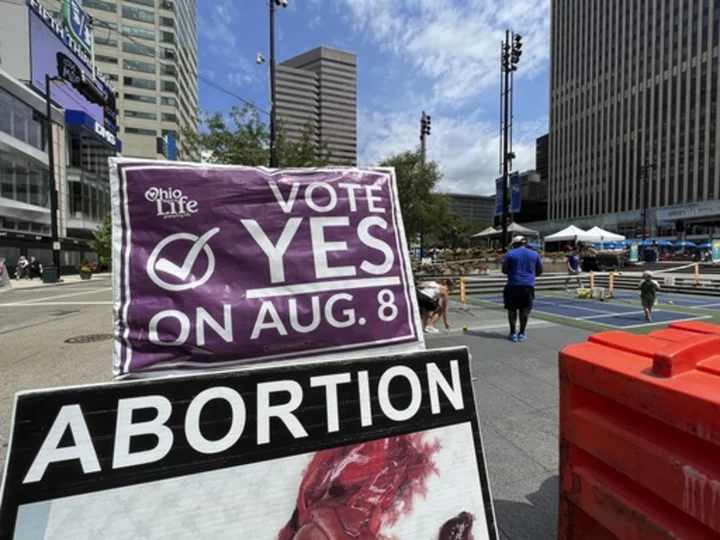
Abortion messaging roils debate over Ohio ballot initiative. Backers said it wasn't about that
The fraught politics of abortion have helped turn an August ballot question in Ohio that would make it harder to change the state constitution into a cauldron of misinformation and fear-mongering
2023-07-24 23:51

Ex-Centerview Banker Puts Elite M&A ‘Partnership’ on Trial
It was at a November 2012 meeting at the University Club on Fifth Avenue that David A. Handler
2023-07-24 23:22
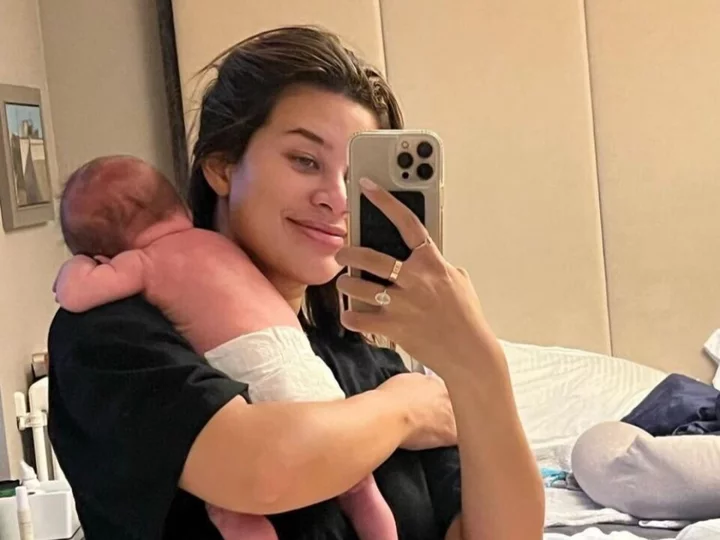
Montana Brown says she chose a home birth because ‘hospital isn’t the safest place for non-white people’
Montana Brown has revealed that she chose to have a home birth when welcoming her son Jude last month because she felt that hospitals are not “the safest place” for non-white people. The former Love Island star, 27, shared a YouTube vlog about her pregnancy and birth plan recently to answer questions from followers about her experience. She opened up about her decision to have a home birth, adding that she hired a doula, a trained professional who supports women through labour and birth, as well as through post-partum. Brown, who is mixed race and has Japanese and Jamaican heritage, said she “can’t wait” for her home birth. She filmed her vlog before giving birth to Jude in June. “I feel like hospital isn’t the safest place to give birth and I know people are gonna be like, ‘What the f***, you’re an idiot’ but I just think it’s personal preference,” she told her followers. “Also, I just think as a non-white person, it’s not the safest place to be in hospital in childbirth. All these things I’ve thought about for a long time. We’re also having a doula, which I’m really excited about.” In the UK, Black women are nearly four times more likely to die in pregnancy and childbirth than white women, according to a report published by MBRRACE-UK (Mothers and Babies: Reducing Risk through Audits and Confidential Enquiries across the UK) in 2022. The study found that there was a slight drop in the maternal mortality rate for Black women between 2018 and 2020. It also found that Asian women are around twice as likely to die in pregnancy and childbirth than white women. In a 2021 response, the government said it was “committed to reducing disparities in health outcomes and experience of care”. Brown, who is engaged to fiancé Mark O’Connor, said she asked for advice on a home birth from The Only Way Is Essex (Towie) star Sam Faiers, who she called the “queen of home birthing”. “It’s just fantastic… She’s helping me feel really set in my decision,” she said. Replying to a fan who asked if she felt afraid of giving birth, Brown said had the “most positive mindset ever”, and would continue to do so even if she had to have a “C-section, an epidural, or wound up in hospital”. The reality star and her fiancé welcomed baby Jude on 23 June. Last week, she opened up about the struggle to get pregnant despite being in her twenties and said she was surprised it took her so long to conceive. Speaking on the Happy Mum Happy Baby podcast, Brown told host Giovanna Fletcher that she thought “something was wrong” with her when she and O’Connor first started trying for a baby. “I thought, ‘We’re young, this is going to be really easy’… For the first four months, we’d used ovulation sticks, and then I’d do a pregnancy test and it’d be negative,” she recalled. After both she and her partner went to check their fertility, they discovered she had “no oestrogen and no testosterone”, which made her realise that people “can be young, fit and healthy, and still really, really struggle to conceive”. Announcing her son’s birth, Brown shared a black-and-white photograph of the newborn being cradled against her chest on Instagram and wrote: “Welcome to the world Jude Isaiah O’Connor. We’re so smitten with you little man.” The couple announced their engagement in April, after O’Connor proposed to her in Bermuda. They first met in 2020. Brown featured in series three of Love Island and was coupled up with Alex Beattie at the end. They broke up shortly after leaving the villa. Read More Ruth Handler: The Barbie inventor who revolutionalised prosthetic breasts and narrowly avoided prison Woman praised for response to airline employee who asked her to swap first class seat with child Fans defend Prince Harry and Meghan Markle amid breakup rumours 8 healthy habits to help you live longer – according to a new study The bowel cancer symptom George Alagiah wished he’d caught earlier George Alagiah: What are the signs of bowel cancer?
2023-07-24 22:47
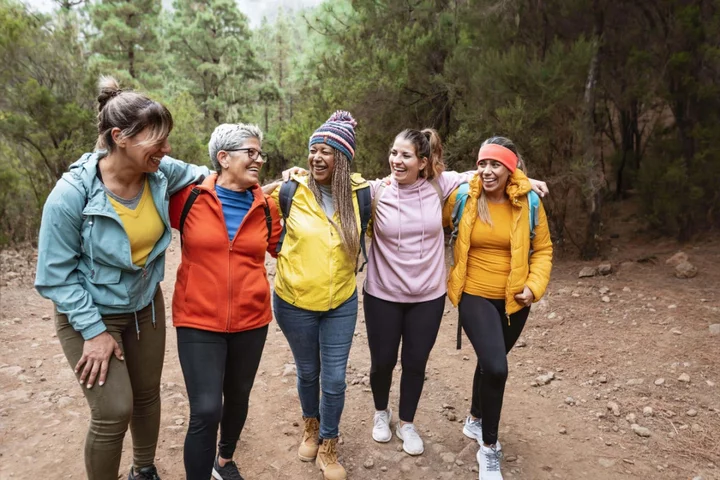
8 healthy habits to help you live longer – according to a new study
Eight habits that could help people live more than 20 years longer have been identified by researchers. While it’s long been known that certain lifestyle factors can influence lifespan, the American study isolated the eight factors that have the biggest impact – being physically active, being free from opioid addiction, not smoking, managing stress, having a good diet, not regularly binge drinking, having good sleep hygiene, and having positive social relationships. The research was presented at Nutrition 2023, the annual meeting of the American Society for Nutrition, and used data from 719,147 people enrolled in the Veterans Affairs Million Veteran Program. It found low physical activity, opioid use and smoking were associated with around a 30-45% higher risk of death, while stress, binge drinking, poor diet, and poor sleep hygiene were each associated with around a 20% increase, and lack of positive social relationships was linked with a 5% increased risk of dying. Men who had all eight habits at age 40 were predicted to live an average 24 years longer than men with none of the habits, according to the findings, and women with all eight habits in middle age were predicted to live an extra 21 years, compared with women with none of the habits. Xuan-Mai Nguyen, health science specialist at the Department of Veterans Affairs, said: “We were really surprised by just how much could be gained with the adoption of one, two, three, or all eight lifestyle factors. Our research findings suggest that adopting a healthy lifestyle is important for both public health and personal wellness. The earlier the better, but even if you only make a small change in your 40s, 50s, or 60s, it still is beneficial.” The researchers say the findings highlight how lifestyle factors contribute to chronic diseases such as type 2 diabetes and heart disease, which are associated with premature disability and death. How to embrace the eight healthy habits Inspired to give your own lifestyle a boost? “If making these small but mighty adjustments could help you to live for an extra 20 years, maybe it’s time to make those changes,” says life and wellbeing coach, Natalie Trice. She shares the following insights and tips… 1. Do more exerciseRegular exercise can help prevent a wide range of major diseases – plus it’s great for keeping stress levels in check. “Going for a walk, having a swim, running with friends, even just a good old dance-off in the kitchen can get your heartbeat up and those feel-good endorphins pumping – so get your trainers on and start moving,” says Trice. 2. Manage stressTrice suggests adopting simple stress-busting practices such as mindfulness meditation, and enjoying hobbies and sports. “These can profoundly impact overall wellbeing, as you bring your stress levels down,” she says. “This isn’t about pretending everything’s great, but rather looking at easy habits you can adopt that will take down the stress, which can lead to anxiety and burnout.” 3. Don’t smoke Quitting smoking is an essential step in improving health and potentially adding years to your life. Trice points out that while some people may think reaching for a cigarette takes the edge off their stress, there are healthier ways to cope. “Maybe going running or taking up yoga could be the release and focus you need, and one that will help you live longer, smell fresher and feel better,” she suggests. “Also, with the cost of cigarettes going up all the time, giving up will free up cash for the things in life that really need to be paid for.”If you are struggling to quit smoking, talk to your GP about options available to help. 4. Don’t binge drink“By cutting down on booze, you’re doing your body and brain a massive favour,” says Trice. “Drinking every night will impact your body and could affect your sleep and work performance. Enjoy life, but if you want to enjoy it for longer, then keep tabs on your drinking.” Official guidelines suggest drinking no more than 14 units of alcohol a week (equivalent to six medium glasses of wine of six pints of beer), spread across at least three days. 5. Eat healthily Generally speaking, a balanced diet that’s rich in fibre, whole grains, fruit and veg and lean protein, with heavily processed and sugary foods kept to a minimum, is linked with better health. “We all know about eating five-a-day but doing this can be tough if you’re busy with family and work. If you can start to do this, you’ll feel better,” says Trice. “Focus on eating regularly and thinking about what you put in your body, so that it works for you, not against you.” 6. Don’t take drugsRecreational drugs can harm health in a number of ways. Trice suggests those affected start by speaking to a trusted friend or their GP, and “look at the support which could not only extend your life, but save it”. 7. Try to get good sleep Trice says: “It’s vital that we look at getting a decent night’s sleep, as this can help you feel so much better. Making sure you have a sleep routine in place can be helpful and can be as easy as having no screens in the bedroom, having a bath or shower before you hit the sack, as well as making sure the temperature is right and you have curtains to keep the light out in the mornings.” 8. Nurture positive social relationshipsTrice observes: “If you’re able to nurture a supportive network of friends, colleagues and family, this can lead to improved mental and emotional wellbeing and a longer life.” Lacking social connections? Look at local volunteering opportunities and community walks and groups. Making friends can take time, but even finding ways to regularly spend time and interact with others can help. Read More Charity boss speaks out over ‘traumatic’ encounter with royal aide Ukraine war’s heaviest fight rages in east - follow live George Alagiah: What are the signs of bowel cancer? Carol Vorderman says she no longer sunbathes after health scare Carol Vorderman: Why my skin cancer scare means I no longer sunbathe
2023-07-24 21:51
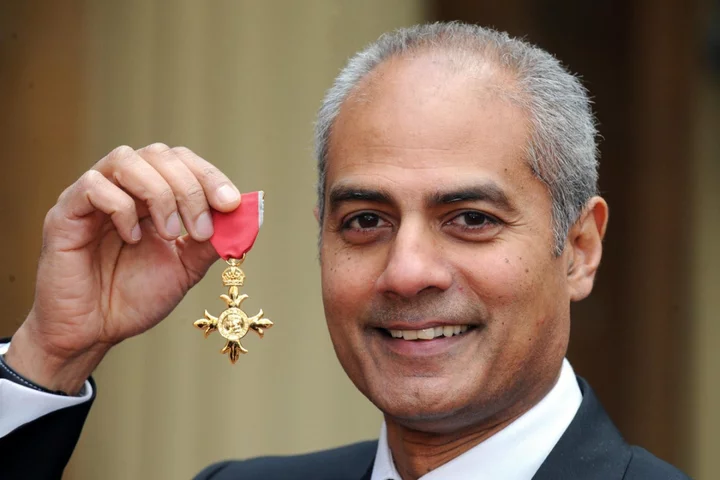
George Alagiah: What are the signs of bowel cancer?
BBC newsreader George Alagiah has died at 67 after being diagnosed with bowel cancer. Bowel cancer is the fourth most common cancer in the UK and leads to around 16,800 deaths every year. More than nine out of 10 cases of bowel cancer develop in older adults over the age of 50, and nearly six in 10 are in people aged 70 or older. Alagiah was first diagnosed with stage four (advanced) bowel cancer in 2014. By the age of 66, it had spread to his lungs, liver, spine and lymph nodes. The three main symptoms of bowel cancer are having persistent blood in the stools, an ongoing change in bowel habit (such as needing to go more often or suffering the runs) and persistent lower abdominal pain, bloating or discomfort. A loss of appetite may also occur, or somebody may suffer significant, unintentional weight loss. Several things are known to increase the risk of bowel cancer, though they cannot explain every case. These include a diet high in red or processed meats and low in fibre, being overweight or obese, not taking enough exercise and drinking too much alcohol. Being a smoker and having a family history of the disease can also push up the risk. Some people also have an increased risk of bowel cancer because they have another long-term condition, such as extensive ulcerative colitis or Crohn’s disease. Bowel cancer screening is currently widely offered to people aged 60 to 74 who are sent a home stool kit every two years. Those aged 75 and over can ask for a kit every two years by phoning the free bowel cancer screening helpline on 0800 707 60 60. Bowel cancer can be very difficult to treat in its later stages. But in the early stages, tumours can often be removed through surgery. The main treatments for bowel cancer include chemotherapy, radiotherapy and targeted drugs, which depend on the genetic make-up of the tumour. One in 15 men and one in 18 women will be diagnosed with bowel cancer during their lifetime. Expert predictions are that 53,646 cases of bowel cancer (29,356 in men and 24,290 in women) will be diagnosed in the UK in 2035. Read More Charity boss speaks out over ‘traumatic’ encounter with royal aide Ukraine war’s heaviest fight rages in east - follow live Carol Vorderman says she no longer sunbathes after health scare Carol Vorderman: Why my skin cancer scare means I no longer sunbathe This is how often you should actually change your razor
2023-07-24 20:27

The bowel cancer symptom George Alagiah wished he’d caught earlier
BBC presenter George Alagiah has died at the age of 67, after nearly a decade of living with bowel cancer. The newsreader was first diagnosed in 2014. He underwent several rounds of treatment after the cancer returned and spread over the last few years. In a statement, his agent Mary Greenham said: “George fought until the bitter end but sadly that battle ended earlier today. George was deeply loved by everybody who knew him, whether it was a friend, a colleague or a member of the public. “He simply was a wonderful human being. My thoughts are with Fran, the boys and his wider family.” Earlier this year, Alagiah opened up about a symptom he wished he had caught earlier. He was taking part in an NHS campaign to encourage the wider public to take up its bowel cancer screening program. He urged people who have received a free test kit from the health service “not to ignore it” because it “could save your life”. “Had I been screened, I could have been picked up. I would have been screened at least three times and possibly four by the time I was 58 and this would have been caught at the stage of a little polyp: snip, snip,” he said at the time. Alagiah received his diagnosis after complaining of blood in his stools. He underwent 17 rounds of chemotherapy and five operations to treat the disease, which eventually spread to his liver and lymph nodes. He supported a campaign by Bowel Cancer UK and Beating Bowel Cancer to make cancer screening available to everyone in England from the age of 50. Currently, screening is available to everyone aged 60 to 74, but the NHS is expanding to include everyone aged 50 to 59 years old. Around 42,000 people are diagnosed with bowel cancer every year in the UK, with 90 per cent of diagnoses made in people over the age of 50. It the fourth most common cancer and the second biggest cancer killer, leading to around 16,800 deaths every year. The three main symptoms of bowel cancer include having persistent blood in the stools; an ondoing change in bowel habits, such as needing to go more often or having diarrhoea; and persistent lower abdominal pain, bloating or discomfort. Some patients may also experience a loss of appetite, or significant, unintentional weight loss. According to Cancer Research UK, another potential symptom is tenesmus, which is the feeling of having to defecate without having stools, or experiencing pain upon defecation. Studies have found that several factors could potentially increase the risk of bowel cancer, although they cannot explain every case. These include a diet high in red or processed meats and low in fibre; being overweight or obese; not exercising often enough; and drinking too much alcohol. Smoking and having a family history of the disease can also increase the risk. Some people with long-term conditions like extensive ulcerative colitis or Crohn’s disease may also have an increased risk of bowel cancer. Bowel cancer can be treated with surgery, which may be paired with chemotherapy, radiotherapy or biological treatments. Catching the cancer at an early stage greatly improves chances of survival. However, the NHS states that if a cancerous tumour cannot be removed completely through surgery, then a cure may not be possible. For more information about treatment for bowel cancer, visit the NHS here and Cancer Research UK here. To speak to a Cancer Research UK nurse, you can call 0808 800 4040. The helpline is free and open from Monday to Friday, from 9am until 5pm. Additional reporting by PA Read More George Alagiah death: BBC newsreader dies aged 67 after bowel cancer diagnosis ‘One of the best and bravest’: George Alagiah obituary as long-serving BBC newsreader passes away ‘It’s not the doom and gloom you might think’: Jonnie Irwin details experience with palliative hospice care
2023-07-24 20:22
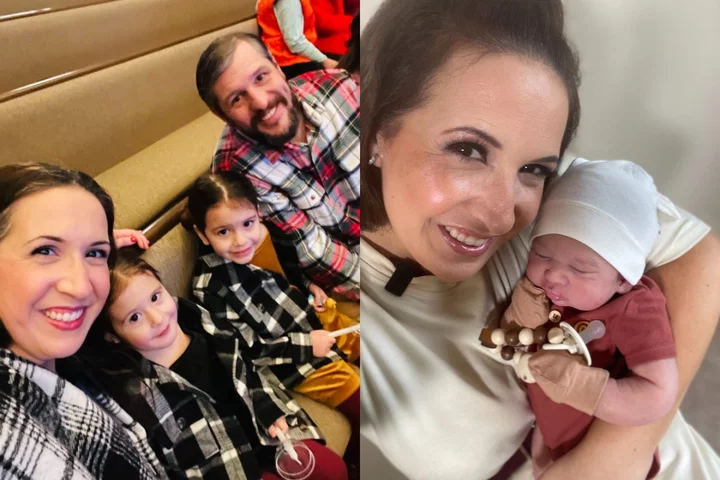
Mum’s husband fired from family business after she roleplayed with reborn dolls
A woman who turned to roleplaying with hyper-realistic dolls “to help (her) cope” with the death of her first baby – and continues to do so with her husband and two rainbow babies – has said her husband’s parents disapproved of the hobby and fired him from the family business as a result. Christina Keeler, 38, a stay-at-home mum and YouTuber, from Wyalusing, Pennsylvania, USA, fell pregnant with her first “miracle” baby in 2015, despite having endometriosis and being told she would not be able to conceive in her 20s. She suffered a miscarriage, but after watching a documentary about so-called reborn dolls, she had a “lightbulb moment” and realised getting a hyper-realistic doll would be the “perfect solution”. Christina’s husband Bill, 43, was “hesitant” at first but became supportive after he saw how much it “helped (her) grief”. The couple went on to have two “miracle” daughters, Grace, six, and Joy, four, who now help feed, change and dress the family’s five reborn dolls – which cost between £1,560 and £3,899 each – in their “nursery” complete with “a crib and a wardrobe”. The family often take the dolls out in public, and have shared their journey on YouTube – where Christina documents people’s reactions to her dolls and birthing videos. Some silicone dolls come in a fake womb which allows a Caesarean section to be performed at home. But Bill’s family were “disgusted” with the hobby, to the point where they gave him a choice to stop having the dolls or leave the family business. He refused to shut down the YouTube channel and did not want Christina to give up her hobby, so he was fired. She fell pregnant with her first baby in 2015, a year after her mother died of cancer. The couple were “elated” about the pregnancy because Christina had been told in her twenties that she would not be able to conceive because she has endometriosis, but she miscarried at eight weeks. Christina told PA Real Life: “When we lost the baby it was so devastating, I remember lying in the hospital bed after they had taken the baby out of my belly, and screaming for my mum and wept wanting to cuddle my baby.” She “really struggled” with the grief of losing her mother and her baby so close together. She explained: “This feeling of sorrow just never went away, it was so painful that I never talked about it again.” Despite having her two “miracle” children Grace and Joy, Christina still longed to hold her first baby, and after watching a documentary about reborn dolls, she wanted to get one to see if it would help her grief. She said: “I felt so blessed to have two healthy girls, but that feeling of missing the first baby never quite went away. “When my youngest was around two years old, my husband and I came across a documentary about reborn dolls. “And he was like, ‘That’s really weird’, and I played it off that I thought the same, but actually I really wanted one to help me cope and I thought it would be the perfect solution.” After persuading her husband, Christina ordered her first lifelike doll, Hannah, costing her around £155. She said: “I told my husband and he was not on board at all, he was hesitant, but after explaining my reasoning, he was much more understanding and more accepting.” When the doll arrived, Christina instantly felt like it helped with her mourning. She said: “It helped me therapeutically because for the first time ever when I got my first reborn doll, I was able to talk about the loss of our baby. “And since then I have healed tremendously from that loss because I’m able to talk about it and share my story and help others – it helped my grief, for sure.” Christina now has a collection of five dolls called Carter, Cadence, Quinn, Isabella and Sammy, which she loves to dress, cuddle and feed. She takes the dolls out in public and people often mistake them for real babies. She said: “We have a nursery for them with a crib and a wardrobe. I check on them throughout the day, and on other days, especially when the girls want to get involved, I pick out an outfit for them, bring them to breakfast, get them to feed them a bottle, change them. “If we’re running errands we often take them out with us and put them in a car seat and stroller.” Christina and her family have been sharing their experiences on YouTube, where they are known as The Reborn Family. She said: “I make videos about people’s reactions to my dolls, as well as vlogs and birthing videos – I have some silicone reborn dolls which come in a womb and you perform a C-section on it at home, to give birth to the baby.” Despite her immediate family being supportive of the hobby, Christina admits not everyone in her wider family understands. She said: “My husband’s family were, and still are, disapproving of the reborns, even though they can see how much they helped me. They were disgusted. “We moved from California to Pennsylvania because my husband was next in line to take over the family business because they were about to retire, and they asked if we would like to do so and we agreed. “When they were on vacation they came across our YouTube channel, and they called us up and they were mortified and so embarrassed, and said we were ruining the family name.” When Bill’s parents came home, they gave him an ultimatum to stop having the dolls. Christina explained: “Bill said that he was not going to quit his job, and didn’t want me to stop having reborns because they were so therapeutic for me at the time, and his dad said, ‘Well, then you’re fired’.” My husband’s family were disgusted, they said we were ruining the family name Bill’s father was contacted by PA Real Life for comment, but he had not responded at the time of publication. Even though her reborns have caused tension in the family, Christina cannot see herself giving up her hobby any time soon. She said: “Reborns continue to help me with my grief, and I love sharing content with other people who have lost babies, and they can also really help people with dementia, people who are infertile, people with anxiety and depression, I wouldn’t want to stop this.” Read More Teenager who thought she was pregnant diagnosed with ovarian cancer Woman praised for response to parents who asked her to swap first class seat with their child Barbie vs Oppenheimer: Greta Gerwig makes history with biggest box office opening for a female director Charity boss speaks out over ‘traumatic’ encounter with royal aide Ukraine war’s heaviest fight rages in east - follow live
2023-07-24 19:24

The new 'private jet'-style airline flying to the Maldives
Beond is a new all-business class airline to the Maldives, based in capital Malé. Launching from Dubai and Delhi, with plans to expand to Europe, it promises lie-flat beds and a "private jet" experience.
2023-07-24 19:17
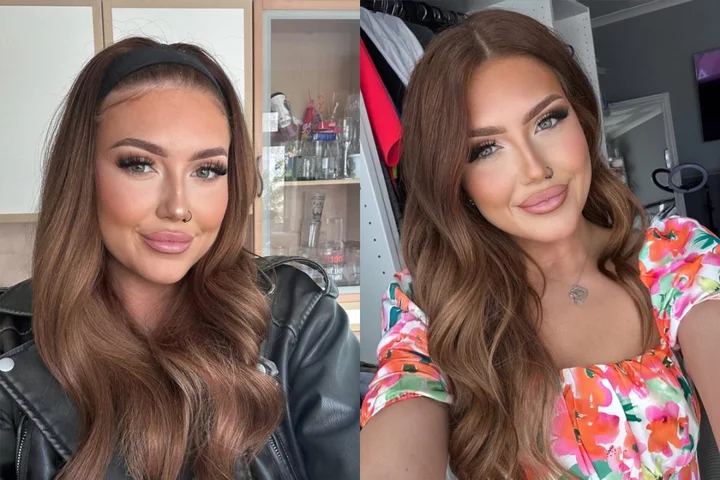
Teenager who thought she was pregnant diagnosed with ovarian cancer
A teenager who thought she was pregnant after her stomach unexpectedly became rounder, and who was told it was constipation by her GP, was later diagnosed with ovarian cancer and is now a student nurse after realising “life is too short”. Summer Edwards, 22, a student nurse at the University of the West of England, from Bristol, went from a size six to size 10 “in a matter of weeks” and thought she was pregnant in 2020, but her GP reassured her that it was constipation. After trying strong doses of laxatives and having two catheters fitted, nothing improved, and she was eventually diagnosed with an ovarian cyst which doctors were able to remove successfully. However doctors then found an extremely rare 19cm by 17cm tumour and Summer was diagnosed with stage one ovarian cancer. Summer had keyhole surgery to remove it, which was a success, but she also found out she had a rare gene, DICER1, which meant she was more susceptible to other types of cancer. Six members of her family have since been diagnosed with the gene, including her 16-year-old cousin who now has lung cancer, but Summer says she is a “fighter”. Since Summer was diagnosed with cancer she has been training as a student nurse, which is something she has “always” wanted to do. In May 2020, at the age of 18, while working in a hospital as a healthcare assistant, Summer began to notice her stomach was getting rounder, but put it down to eating a few extra treats at work. She said: “My mum was convinced I was pregnant, and I began to believe it, but I took a pregnancy test and it came back negative. “I went from a size six to size 10 in a matter of weeks, and one day I was in the garden in a bikini and my mum said that she thought something was really wrong because my stomach was really round.” To reassure her mum, Summer went to her GP and was prescribed a strong dose of laxatives, as they thought she was constipated. But after two weeks of taking the medication nothing changed, so Summer was called in to her GP surgery. Summer said: “The doctor felt my stomach and they said something was not right, but I didn’t think much of it.” Summer also had blood tests, and spotted that her blood was being run for a CA-125 test, a tumour marker for ovarian cancer, and a few days later was asked to have an internal ultrasound, where she was told her bladder was “completely full” with more than a litre of urine. Doctors told Summer there was “nothing they could do at that point” so, after asking her doctor friend for advice, she went straight to A&E and had a catheter fitted. She said: “I was devastated, I was only 18 and I really didn’t want to be walking around with a catheter strapped to my leg or be signed off work for 12 weeks.” After a few days of being catheterised, Summer continued urinating as usual, so she returned to the hospital and had another fitted. But the following day she began experiencing a great deal of pain. She said: “It was weird, I went to the toilet and I noticed a lot of blood in the bag, and I was still weeing. “I was taken into hospital – at this point, I was screaming in pain.” Summer then had a CT scan, and it was found that her bladder was never full – instead, she had a large ovarian cyst which was successfully removed with surgery. But two weeks later Summer went for her post-operation check-up and was told she had a 19cm by 17cm tumour. She said: “They told me I had a Sertoli-Leydig cell tumour, which was really rare. “They told me there was only one other person in the UK that had it at that point and my blood tests came back fine on the CA-125 marker because it causes a boost in testosterone so didn’t show as a marker. “It didn’t sink in at all, and the first thing I did was take my sick note to work – I was gutted I couldn’t work. “When I told people there, they cried, so I did too, but it didn’t hit me for a while.” On July 1 2020 Summer had a hospital appointment to find out more about her tumour, and to her devastation she found out she had ovarian cancer. She said: “They explained more about my tumour, and that there have not been any clinical trials for it because it’s so rare. “I put it bluntly and asked them if I had cancer and they said yes. “My mum was upset about it more than me – I think it’s more scary for those around you.” About two weeks later Summer had keyhole surgery to remove the tumour, which was a success. She said: “I was so relieved, and in my post-op review they asked me if I wanted preventive chemotherapy and I said no, as the pros outweigh the cons for me. “I’d rather live my life now and deal with chemotherapy in the future if it ever comes back.” Since then Summer has had internal ultrasounds every three months, which will continue for the next ten years. She has also been genetically tested, and she was diagnosed with DICER1 syndrome – an inherited disorder that increases the risk of cancerous tumours, most commonly in the lungs, kidneys, ovaries and thyroid. Summer said: “I now know that if I have kids, they will probably have the gene, and I’ve looked into IVF and PGD (preimplantation genetic diagnosis) but there is no licence to test for DICER1, I’d have to go and ask for one to be made. “I know that I’m probably more likely to get another type of cancer in the future too.” Summer’s immediate family tested negative for the gene, but when Summer’s aunt came to one of her appointments with her, she believed her daughter, Summer’s 16-year-old cousin, had the gene. Summer said: “After tests, my aunt and five of her children have the gene, and one of them has lung cancer but she’s a fighter.” Now Summer is a student nurse – she has “always wanted” to work in healthcare, and has been doing so since she was 17, but when she received her cancer diagnosis it pushed her to apply for university. She said: “My tutors are amazing and I have had time off for scans and things, but I absolutely love it. “Having the diagnosis made me realise there’s no time to wait and life is too short.” For more information, visit: targetovariancancer.org.uk/ or www.nhs.uk/conditions/ovarian-cancer/. Read More Teenager who thought she was pregnant diagnosed with ovarian cancer Jonnie Irwin details experience with palliative hospice care Carol Vorderman shares warning to sunbathers after skin cancer scare Jonnie Irwin details experience with palliative hospice care Carol Vorderman shares warning to sunbathers after skin cancer scare This is how often you should actually change your razor
2023-07-24 18:56

Rhodes fires: Holidaymakers praise locals as wildfires rage on
Wildfires have also broken out on the Greek islands of Corfu and Evia as thousands are evacuated.
2023-07-24 18:51
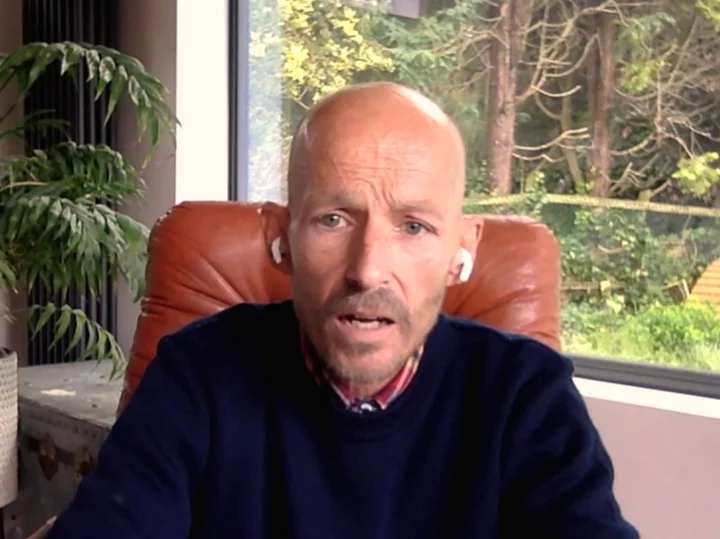
‘It’s not the doom and gloom you might think’: Jonnie Irwin details experience with palliative hospice care
Jonnie Irwin has spoken out about his “really good” experience with palliative care in a hospice, amid his journey with terminal cancer. The A Place In The Sun presenter, 49, appeared on BBC Morning Live on Monday (24 July) and gave viewers an update on his current health and treatment. Reassuring hosts Gethin Jones and Helen Skelton that his family is doing “great and very noisy”, Irwin was asked about his experience with palliative care, which focuses on improving the quality of life for anyone facing a life-threatening condition. Irwin said that he has been in palliative care since the day he received his terminal cancer diagnosis. He was first diagnosed with lung cancer in August 2020, but only publicly shared the news in November 2022 after it spread to his brain. He described his hospice experience as a “delight”, adding that his initial perception of such facilities were that they were “very much a boiling hot room full of people who looked frail and towards the end of their days”. However, it was “nothing of the sort” when he did actually go in. “It’s spacious, energised, comfortable,” Irwin told the show, adding: “I’ve had a really, really good experience at my hospice.” He urged anyone who is facing a terminal diagnosis to “embrace” end-of-life care and to try going to a hospice if they have been offered the choice. “My first experience of palliative care and hospice was blood transfusions,” he explained. “I had my first blood transfusion in hospital and then was invited to use the hospice, so I have it a go as a day patient and went into a lovely room. “I implore people to check out hospices. If you’ve got the choice of using it, then use it… I encourage people to explore that option because it’s not the doom and gloom operation you might think it was.” In June, Irwin made a rare red carpet appearance at the Television and Radio Industries Club (TRIC) Awards and said he is taking “every day as a gift as it comes”. When he first revealed his terminal cancer diagnosis, the Escape To The Country host said he “doesn’t know how long” he has left to live, but hopes he will inspire people to “make the most of every day”. He also celebrated his “best ever” Father’s Day last month with his three sons, Rex, four, and twins Rafa and Cormac, three, with wife Jessica Holmes. Irwin recently revealed that sometimes he has to “remove himself” from his family home to go to a hospice when he is in a lot of pain because it makes him “not good to be around”. He told Hello! magazine: “I’m like a bear with a sore head and I don’t want [my family] to be around that.” In another appearance with podcast OneChat previously, he said that being in pain affects his mood, explaining: “I have been close to death’s door, twice at least. You lose your memory, you lose your patience. I have got a very short temper. It’s not made me a better person, that’s for sure.” Read More Ruth Handler: The Barbie inventor who revolutionalised prosthetic breasts and narrowly avoided prison Fans defend Prince Harry and Meghan Markle amid breakup rumours Tim Shaddock rescue: Ben Fogle offers to pay for Australian sailor and dog to be reunited after emotional separation Carol Vorderman shares warning to sunbathers after skin cancer scare This is how often you should actually change your razor Are we working out too hard?
2023-07-24 17:22
